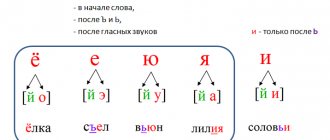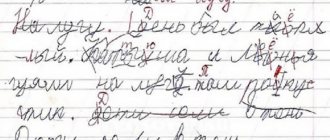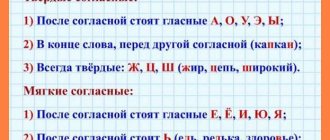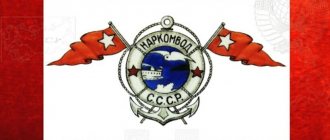Syllables are the parts into which a word is divided during oral speech. When we pronounce a word, we get several exhalation pushes of air - this is exactly the pronunciation by syllables: cat. Two pushes of air when exhaling - two syllables: vo-da. 3 puffs of air - three syllables: na-u-ka.
A word has the same number of syllables as there are sounds from the voice, that is, vowels: sheet - 1 syllable, no-ra - 2 syllables. A syllable can have a very different number of letters, but one must be a vowel.
A word can have a different number of syllables. There are one-syllable, two-syllable, three-syllable words and polysyllabic words: leaf (1 syllable), no-ra (two-syllable word), u-e-zhat (three-syllable).
A syllable can consist of one vowel sound or a combination of a vowel and a consonant: a-ba-zhur. Even one vowel sound is already a syllable. But one consonant is not a syllable. How to divide a word into syllables? It is important to understand the main principle: if a syllable includes a vowel and a consonant, then it always begins with a consonant: no-chnik, country.
Monosyllabic words
Based on the minimum number of vowels in a word, we select monosyllabic words that contain one phonetic syllable. Let's remember what a phonetic syllable is.
Definition
A phonetic syllable is one vowel sound or a vowel combined with one or more consonant sounds, which in the process of speaking are pronounced with one impulse of exhaled air.
Place your palm under your chin and clearly pronounce the words:
laz, march, elk, bridge, leaf, moment, cheese, test, look
On vowels, the chin will hit the palm once. This means that these words are monosyllabic.
Additional material
Let's learn in more detail about the composition of monosyllabic words with one, two, three, four consonants.
A selection of collages from 1 to 8 type of syllable structure of the word
Type 1: two-syllable words Vocabulary: summer, sky, clouds, hut, willow, puma, fly, wasp, fly, goat, pony, water, mud, toad, children, Vanya, Nata, saw, magnifying glass, cotton wool, owl, notes , leg(s), paw(s), vase, perfume, udder, horns, ear(s), hand(s).
Type 2: three-syllable words made from open syllables Dictionary: Polina, spiders, Panama hat, lipstick, bouquets (lilies, irises), newspaper, coins, macaque, honey mushrooms, raspberries, bananas, dishes, milk, lemons, loaves, vegetables, tomatoes, irons , ducklings, boots, cubes, car, cabin, wheels, brooms, kittens, dog, berries, raspberries.
Type 3: monosyllabic words Dictionary: Grandfather, night, forest, cat, bull, horse, juice, soup, cancer, poppy, oak, house, goose, fluff, ball, mouse, tank, beetle, moss, stump, hedgehog, elk , whale, cheese, onion, knife, tea, honey, horn.
Type 4: two-syllable words with a closed syllable Dictionary: Ivan, ottoman, puppy, medal, fireplace, fire, castle, boar, torch, sunset, hammock, runner, sock, ticket, rope, rooster, python, hamster, buffet, can, spider, bouquet, banana, loaf, lemon, coconut, broom, dustpan, raccoon, sofa, package, sack, swan.
Type 5: two-syllable words with a cluster of consonants in the middle Dictionary: Olga, skirt, T-shirt, slippers, bows, bucket, sponge, stain, shelves, barrel, jar, oil, cherry, pumpkin, mice, cat, bowls, window, pine, branch, pine cone, lamp, letter, pen, waffles, cup, palm tree, flowerpot, watering can, duck, cabinet, bear, hat, thread, doll.
Type 6: two-syllable words made from closed syllables Dictionary: Pavlik, Anton, cactus, pot, balcony, tray, jug, compote, omelet, broth, teapot, tulip, turkey, worm, fountain, dolphin, bear, trap, bunny, spruce forest, forester (Maxim), bulldog, umbrella, rain, peacock, chestnut, chest, magnet, pearls, compass, donut, cog.
Type 7: three-syllable words with a closed syllable Vocabulary: airplane, parachute, steam locomotive, bell, rhinoceros, hippopotamus, calf, vegetable garden, squash, zucchini, tomato, cucumber, duckling, ant, mantis, diver, fisherman, pelican, whale, captain, parrot, steamboat, telephone, suitcase, kitten, mouse, waterfall, little fox, hedgehog, elk calf, owlet, nightingale, sparrow, lumberjack, boletus. Possible names: Nikolai, Elisha, Timofey, Seraphim.
Type 8 SSS: three-syllable words with a combination of consonants Dictionary: village, grandmother, grandfather, grandchildren, girl, Tanechka, bun, slippers, Vanechka, shirt, cap, popsicle, gazebo, bagels, tree, Christmas tree, needles, cones, lilies of the valley, frog , sparrows, hen, chickens, apple tree, apples, bug, daisies, butterfly, cuckoo, tureen, sausages, plate, salt shaker, cabbage, snail, ladder, fishing rod, bench, oyster mushrooms, basket, berries, blueberries.
Two-syllable words
According to the number of syllables, words can be polysyllabic: two-, three-, four-syllable, etc.
Two-syllable words, as can be determined by their name, contain two vowel sounds.
Examples
sli-va, chair-chick, fence, city, kro-na, te-ma, u-kaz, island, a-gent, i-gla, snake-ya, evening
When pronouncing them, the chin will fall onto the palm twice, as there will be two shocks of exhaled air.
Additional material
We will learn about how to divide words into phonetic syllables and what needs to be taken into account with examples in the article about two-syllable words.
Not all two-syllable words can be transferred from one line to another in accordance with phonetic syllable division. A number of words in which a single vowel forms an independent syllable cannot be transferred, leaving one letter on the line, for example:
- snake-me - snake
- u-dar - blow
- o-braz - image
- i-gla - needle
- a-nis - anise.
Why be able to divide a word into syllables?
Isolation of syllables is important for the correct hyphenation of words; the syllabic principle is the main one in competent hyphenation, although not the only one. Both skills are important: identifying syllables in a word and the ability to find morphemes (meaningful parts of a word), because syllables and morphemes in many cases do not coincide. The syllable is not a prefix or root, or a suffix.
Division into syllables occurs when a word is pronounced. And dividing a word into parts is necessary for writing a word, that is, for writing letters in prefixes, roots, and suffixes.
Isolation of morphemes (prefixes, suffixes, roots) and syllables are two different actions, two different principles on the basis of which competent transfer of words is carried out.
For example, when transferring a word syllable by syllable, you need to simultaneously see the root and prefix, so that, for example, you do not tear off the first and last letter of the root or break a monosyllabic prefix.
There are a number of transfer rules that rely on the ability to divide a word into syllables and morphemes at the same time. Therefore, you need to be able to do one and the other.
Three-syllable words
A word can have more vowels than two. Three vowel sounds combined with consonants form three-syllable words. When pronouncing a three-syllable word, three impulses of air occur, but one of them is stronger, which is created by the stressed vowel, and two are weaker in unstressed syllables. Let's make sure of this by saying the words:
let-tchi-tsa, ko-ro-va, be-know
Examples of three-syllable words
In three-syllable words, consonants are grouped with vowels with two, three or even four sounds per syllable, for example:
- do-ro-ga, bo-ro-da, so-ro-ka;
- pri-sta-vka, kra-so-ta, te-le-fon, ka-ran-dash, bu-ma-zhka;
- jump up, shake up, jump up, wait, look.
A vowel can form an independent syllable in a three-syllable word:
- a-ktri-sa, a-zbu-ka, a-na-us, a-ra-his;
- o-city, o-val-ny, o-fresh-to-live, o-tli-chnik;
- u-gol-nik, u-ra-gan, u-chi-tel, u-slit.
Please note that the orthographic transfer of the words given above does not coincide with their syllable division due to the presence of a single vowel in their sound composition.
Additional material
Let's learn the rule of word hyphenation in Russian.
Let's compare phonetic syllable division and orthographic hyphenation of words:
| Phonetic syllable division | Spelling hyphenation |
| u-gap-e | gorge |
| garden | garden |
| o-tli-chnik | personal name |
| ABC | ABC |
| Hurricane | Hurricane |
| destination | destination |
How to divide a word into syllables with a combination of consonants
How to divide a word into syllables if there are several consonants nearby in the middle? How to correctly break a word into syllables: cat or cat? You need to understand the principle of so-called greater sonority. It is observed in the second case. From consonant to vowel. First there is a dull sound, then a voiced consonant, and at the end a vowel - shka. The first syllable ends with a vowel (ko). Such syllables are called open. We have much more of them than those that end with consonants: table, chair (they are called closed syllables).
In the middle of a word, the syllable is usually open, that is, it ends with a vowel sound: stra-na. According to the principle of increasing sonority, all consonants move in most cases to the subsequent syllable: cat.
If several consonants are combined in the middle of a word, then all the consonants following the vowel go to the next syllable: o-flow. These can be the same consonants or simply combinations of different consonants: o-flow, sha-pka, ko-shka.
An exception to this point: only those syllables in the middle of a word that end with unpaired consonant voiced sounds (they are called very voiced, sonorant) end with a consonant: [й], [р], [р'], [л], [л '], [m], [m'], [n], [n']: may-ka, San-ka, man-ka.
If in a word several sounds merge into one sound, then they all go to one syllable: zhu-zhzh (Zh)at, distracted (CA). In these cases, one should not confuse division into syllables and morphemic division for transferring a word: for example, we divide o-teket by syllables, but for transfer we divide the same word like this - ot-tek.
Which words have more sounds than letters in Russian: list of words
If you parse the word phonetically, the result will be the following picture: the number of sounds will not correspond to the number of letters in the word. It often happens that there are more sounds in words than the letters themselves. And if you also know which words have more sounds than letters in the Russian language, then you will definitely remember the information that the teacher taught at school. Below is a picture where there are examples of the correct spelling of words and their phonetic analysis, or rather the word is broken down into sounds.
Words, sounds
As you can see, one thing is written, but another is heard. Look below for some examples of such words in Russian grammar:
- Christmas tree - (Yolochnaya) comes out with seven letters and eight sounds
- Mayak – (mayak) four letters, five sounds
- Yula – (yula) three letters, four sounds
- Blizzard - (blizzard)
There are many such words with more sounds than letters in Russian grammar. And knowing the rules when a vowel and a consonant mean two sounds, you can give many examples on your own. Below, see some more examples of such words.
Letters representing two sounds
Examples:
- Yeralash – ⌈yiralash⌋
- Apples – ⌈apples⌋
- Caustic – ⌈yeetk`ie⌋
- Raccoon – ⌈yinot⌋
- Christmas tree – ⌈yolka⌋
- Capacious – ⌈yomk`iye⌋
IMPORTANT: When a word has a soft, hard sign and there are vowels: E, E, Yu, I, then the letters and sounds will be equalized due to the fact that the soft, hard signs do not have any sounds.
Sound superiority
Let's list the rules when there are more sounds than letters. Exercises in phonetic analysis of lexical units often cause difficulties for pupils and students. Words that have fewer letters and 1-2 more phonemes are often difficult to parse letters and sounds.
Note! A letter is a graphic unit, an icon used in writing. Sound is a phonetic unit that indicates the sound of a graphic icon when pronounced.
Such discrepancies arise if the letters “e”, “e”, “yu”, “ya” are present in the lexeme under study.
These vowels are special, they have their own trick, which lies in their special expression in speech: they do not have their own personal phoneme.
In the case when the listed vowels are in a position after a consonant, they soften it. And in addition to this, vowels are pronounced as their opposite: “e” like “e” or “i”, “e” like “o”, “yu” “u”, “ya” “a”.
For comparison: onion (the consonant “l” is hard, because after it there is a vowel “u”), hatch (“yu” softens the consonant “l” and turns into “u”).
This is interesting! Increasing literacy: how many vowel sounds are there in the Russian language?
In other cases, each of them breaks down into 2 phonemic units, one of which is “th”, the second is the pronunciation of the opposite vowel. Due to them, the number of sounds can be increased.
This happens in positions when:
- “cunning” vowels are at the beginning of the word (raccoon, fir tree, cabin boy, apple),
- come after vowels (fought, yours, edge, mine).
Important! Learning the rule is not difficult: it will take no more than 5 minutes, but it will help prevent mistakes in the future.
Game one
To teach a child to read syllables, you first need to learn the syllables starting with the letters “a”, “u”, “i”, “o”, then “e”, “e”, “s”, “yu”, “e”, “ I". Choose syllables starting with the letters “a” and “u”, read them with your child slowly.
Then you can use these syllables to form simple words and read them with your child.
We read and form words with the letters “a”, “u”: a-u, ma-ma, pa-pa, ra-ma, ma-sha, soup, lu-zha, ka-sha, mu-ha, zha- ba.
Now add the letter "o".
We read and form words with the letter “o”: house, mouth, so-va, cat, stake, crowbar, ox, but-ta, vo-da, ko-za.
Add the letter "i".
We read and form words with the letter “i”: li-sa, si-la, pi-la, li-pa, Mi-la, gu-si, zi-ma.
Add the letter “e”, “e”.
We read and form words with the letter “e”, “e”: hedgehog, ruff, se-lo, ne-bo, be-da, de-lo, zhe-le, le-to, sea-re.
Add the letter "s".
We read and make up words with the letter “s”: we-lo-un-you, cheese, fish-ba, sha-ry, cha-sy, bu-sy.
Add the letter "e".
We read and form words with the letter “e”: e-ra, e-mu, e-ho.
Add the letter "yu".
We read and form words with the letter “yu”: Yu-ra, yu-la, Yu-la, yur-ta, u-yut.
Add the letter "I".
We read and form words with the letter “I”: Ya-sha, Ya-ma, Ya-na.
Word Analysis Example
For comparison, below are several analysis samples for which words with fewer letters and words with the same letter-sound number were taken:
- Lighthouse. There is “I” here, it is in the position after the vowel “a”, which means it breaks up into “y-a”. There are no other special cases. Let’s write the transcription as follows: “mayak”, according to it, the word consists of 5 sounds. This means it has 5 sounds and 4 letters, the number does not match.
- Snowstorm. There is “yu” here, its position - after “b” means it breaks up into “y-y”. There is also “b”, which is not pronounced at all. We will write the transcription as follows: “v’yuga” (“b”) 5 stars, 5 b. Since “b” was not included in the transcription, the quantity is equalized, despite the fact that “yu” disintegrated into “y-u”.
- Yula, only 3 letters. There is “yu” here, the position is the beginning, which means it breaks up into “y-y”. There are no other special cases. Let's write the transcription like this: “Yula” 4 sounds. The quantity did not match.
- Christmas tree decoration). There is “е” here, the position is the beginning, which means it breaks up into “y-o”. There is also “ya”, it is in the position after the vowel - which means it breaks up into “y-a”. There are no other special cases - most likely, there will be fewer graphic signs here than phonetic units. For approval, let’s write down the transcription: “Yolochnaya” 9 stars, 7 b.
Cabin: phonetic analysis of the word
We examined samples of phonetic analysis: 3 words with more sounds than letters (lighthouse, yula, fir-tree), one with the same meaning of units (blizzard). To complete the task correctly, attentiveness and knowledge of theoretical material are required.
Determining the number of sounds
The presence or absence of “tricky” vowels will help you quickly determine which word has more phonemes than graphic icons.
To find out whether the elements being studied coincide in quantity, you need to perform a certain sequence of actions.
The algorithm is as follows. Write out the word being analyzed from the text and look carefully to see if it contains “e”, “e”, “yu”, “ya”.
If so, determine their position:
- after a consonant,
- after hard or soft signs,
- after a vowel,
- the very beginning.
This is interesting! We speak competently: is there a word no in Russian?
Continue analysis depending on position:
- If they come after a consonant, then most likely the number will match (unless there are other special cases of phonetics, as well as ъ/ь),
- When the listed vowels come after ъ/ь, the number will most likely coincide (these signs do not have a phoneme),
- The positions at the beginning of the word and after the vowel indicate that we have before us the situation under consideration with the formation of an additional phoneme.
- To confirm the correctness of your reasoning, you need to make sure that there are no other special cases of phonetics in the lexical unit under study.
The expression “special phonetic cases” refers to phenomena that influence the difference in the number of units under study.
Word phonetic analysis plan
These are the following cases:
- doubled and unpronounceable consonants,
- hard/soft signs,
- vowels “e”, “e”, “yu”, “ya”.
Important! If a word containing the vowel e, ё, yu or ya includes a soft or hard sign, there will be an equal number of phonemes and graphic signs (unless there are other special cases), because the hard and soft signs are not pronounced and do not have a phoneme.









